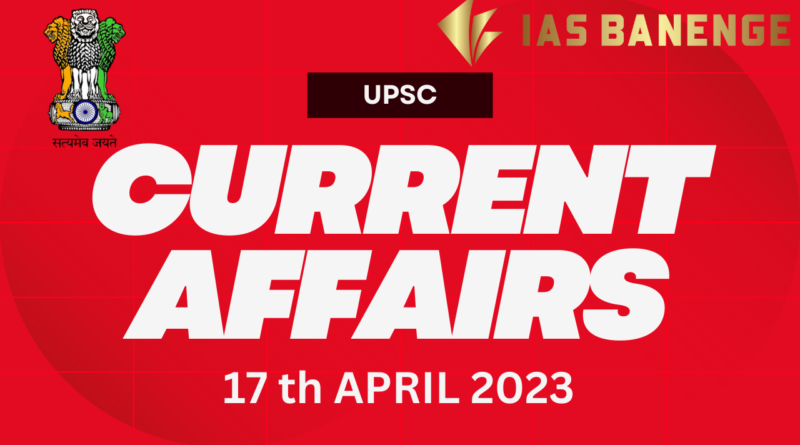Current Affairs 17 April 2023 Ias Banenge
CONTENTS
- Conflict between Israel and Syria
- Uttaramerur inscription
- Quantum Technology for Securing Maritime Communications
- Dark matter
- Heatwaves
Conflict between Israel and Syria
Context:
Recently, Israel has fired retaliatory rockets after three rockets had been launched towards Israel from Syria.

Relevance:
GS II: International Relations
Dimensions of the Article:
- Recent Conflict in Israel and its Neighboring Countries
- Timeline of Conflict between Israel and Syria
- India’s Position in the Syrian-Israeli Conflict
Recent Conflict in Israel and its Neighboring Countries:
- Tension due to ultra-nationalist government in Israel
- Raid on Al-Aqsa Mosque in Jerusalem by Israel leading to rocket attacks from Lebanon, Gaza Strip, and Syria • Israel’s fear of Iran stationing its fighters and weapons near its borders via Syria
- Israel’s strikes in Syria targeting Iranian-linked figures and infrastructure, including airports in Damascus and Aleppo
- Complexity of the situation with multiple actors and competing interests
- Ongoing conflicts resulting in displacement of millions and loss of countless lives
- International community calling for calm and peaceful resolution, but uncertainty prevails.
Timeline of Conflict between Israel and Syria:
- Six-Day War in 1967: Israel seized Golan Heights from Syria, which it has occupied since then.
- Yom Kippur War in 1973: Syrian forces attempted to recapture Golan Heights but failed.
- Israel’s Golan Heights Law in 1981: Israel passed a law effectively annexing Golan Heights, which was declared null and void by the UNSC.
- Failed Negotiations in 2000: Israel and Syria attempted to negotiate a settlement but failed.
- Syrian Civil War in 2011: Conflict between Israel and Syria escalated after the start of the Syrian civil war.
- Iran’s Involvement: Iran emerged as a key player in the conflict and provided support to Syrian President’s regime.
- Targeted Strikes in Syria: Israel has been accused of carrying out targeted strikes in Syria in recent years, with recent attacks raising concerns of escalation.
- READ MORE- Editorials/Opinions Analysis For UPSC 17 April 2023 Ias Banenge
India’s Position in the Syrian-Israeli Conflict:
- India maintains a balanced position and urges all parties to exercise restraint and resolve differences through negotiations.
- India supports Syria’s sovereignty and territorial integrity and opposes external interference in its internal affairs.
Implications of Conflict for India:
- The conflict could impact India’s energy security as it heavily relies on oil imports from the Middle East, including Syria.
- Any disruption in oil supply could have significant economic consequences.
- The conflict could also have security implications for India as extremist groups in the region may exploit the situation to further their agenda.
- India’s significant Muslim population could be impacted, and sectarian tensions could rise if the conflict escalates.
Uttaramerur inscription
Context:
Prime Minister referred to the Uttaramerur inscription in Kanchipuram, Tamil Nadu, while discussing India’s democratic history.
Relevance:
GS I: History
Dimensions of the Article:
- Where is Uttaramerur?
- What does the inscription say?
- Is this an example of a democracy?
Where is Uttaramerur?
- Uttaramerur lies in present-day Kanchipuram district, approximately 90 km southeast of Chennai.
- Today, it is a small town and had a population of roughly 25,000 in the census of 2011.
- It is known for its historic temples built during Pallava and Chola rule.
- The famous inscription from Parantaka I’s reign is found on the walls of the Vaikunda Perumal Temple.
What does the inscription say?
- The Uttaramerur inscription provides details on the functioning of the local sabha or village assembly.
- A sabha was an assembly exclusively of brahmans and had specialised committees tasked with different things.
- The inscription lists the process for appointing representatives to the sabha and the qualifications required for the position.
- Factors that disqualify someone and their family from consideration are also listed.
- The representative would be chosen on the basis of an elaborate draw of lots, conducted by priests in the inner hall of the building where the assembly meets.
Responsibilities of the Sabha
- The inscription describes a number of important committees within the sabha with their own distinct functions.
- These committees include the garden committee, the tank committee, the annual committee, the committee for supervision of justice, the gold committee, and the five-fold committee.
- The committee assignments would last for 360 days after which the members would have to retire.
- Any member implicated in any wrongdoing, such as forgery or having ridden a donkey (i.e. being punished for a crime), was removed instantly.
- The inscription emphasises upon the keeping of accounts as any discrepancy can also disqualify members of the sabha.
Is this an example of a democracy?
- The Uttaramerur inscription describes a system of local self-government, but it is not a truly democratic system due to restrictions on membership to only land-owning brahmans and lack of true elections.
- However, it can be seen as a precedent for democratic functioning and as a constitution-like document detailing responsibilities and limitations to authority.
- While the idea of a modern democracy is a recent phenomenon, the inscription’s emphasis on the rule of law aligns with essential components of a democracy.
-Source: Indian Express
Quantum Technology for Securing Maritime Communications
Context:
RRI (Raman Research Institute) has inked a Memorandum of Understanding (MoU) with the Indian Navy on Quantum Technologies to develop secure maritime communications.
Relevance:
GS III: Science and Technology
Dimensions of the Article:
- Details
- Quantum technology
- Quantum Communication
- Quantum Technology in Maritime Communication
Details:
- Raman Research Institute (RRI) Agreement with Indian Navy for Quantum Key Distribution:
- RRI is an autonomous institute of the Department of Science and Technology (DST) in India.
- RRI’s Quantum Information and Computing (QuIC) lab will lead the research efforts towards developing Quantum Key Distribution (QKD) techniques.
- The research aims to enable the Indian Navy to use QKD for securing free space communications.
- The agreement is part of the Indian Navy’s efforts towards enhancing its technological capabilities and securing its communications.
Quantum technology:
- Two objects cannot occupy the same space at the same time, according to classical physics (based on Newtonian mechanics)
- It was thought until the early twentieth century that this was a fundamental physics law that was followed by everything in nature
- However, scientists began to look into particles like atoms, electrons, and light waves that did not appear to follow these laws.
- The subject of quantum mechanics was founded by Max Planck, Neils Bohr, and Albert Einstein in an attempt to investigate the “quirky” principles that did bind such particles.
About:
- It is a type of technology (developed in the early twentieth century) that operates on the principles of quantum mechanics – the physics of subatomic particles, such as quantum entanglement and quantum superposition.
- As a result, it is based on phenomena exhibited by microscopic particles (such as photons, electrons, atoms, and so on) that differ significantly from how normal macroscopic objects behave.
There are Four domains of Quantum Technology:
- Quantum communication
- Quantum simulation
- Quantum computation
- Quantum sensing and metrology
The underlying principles of quantum technology are as follows:
Quantum entanglement (QE):
- Quantum entanglement occurs when two atoms are connected or entangled despite their separation
- If one atom’s properties change, the other changes instantly, and quantum mechanics observe these changes in properties.
- It improves communication security by using quantum-protected encrypted keys, and entangled atoms can be used to detect whether data transmission has been compromised.
Quantum entanglement:
- Quantum superposition is the theory that subatomic particles can exist in multiple states at the same time.
- Quantum computers are a practical application of this principle.
- Whereas digital computers store data as bits (binary of 0 and 1), quantum computers use qubits, which can be either a 1 or a 0 at the same time.
- This superposition generates a nearly infinite set of options, allowing for extremely fast calculations.
Applications:
Quantum technology promises to improve a wide range of everyday devices, including:
- Improved navigation and timing systems.
- Improved communication security.
- Improved healthcare imaging through quantum sensing (using quantum phenomenon to perform a measurement of a physical quantity).
- Quantum computers provide more powerful computing.
- Improved disaster management through better prediction, computing, and so on.
- To comprehend biological phenomena such as smell and consciousness, as well as the spread of pandemics such as Covid-19, etc.
Quantum Communication:
- Quantum communication is a subfield of quantum technology that aims to develop secure communication systems using quantum mechanics principles.
- It uses a different approach to encryption compared to traditional methods.
- Quantum Key Distribution (QKD) is the most common example of quantum communication that generates an almost uncrackable encryption key between two parties.
Mechanism of Quantum Communication:
- Encoding Information: Information is encoded on qubits, which can exist in multiple states simultaneously, known as superposition.
- Transmitting Information: Qubits are sent over a quantum communication channel, such as a fiber optic cable or a free-space link, usually one at a time.
- Receiving Information: The receiving party measures the qubits with a quantum measurement device that collapses the superposition state, revealing the encoded information.
- Detecting Eavesdropping: Any attempt to eavesdrop on the communication disturbs the quantum state of the qubit, making it instantly detectable, known as the “no-cloning theorem”.
- Establishing a Secret Key: By exchanging qubits, the transmitting and receiving parties can establish a secret key that can be used with conventional encryption algorithms to ensure the confidentiality and integrity of transmitted information.
Quantum Technology in Maritime Communication:
- Quantum encryption can provide secure communication between ships and shore stations, making it difficult for hackers to intercept or eavesdrop on the communication.
- Quantum entanglement can enable faster communication between ships and shore stations over long distances, which could be particularly useful in remote areas with limited traditional communication methods.
- Quantum sensors can improve navigation accuracy by measuring the Earth’s magnetic field with high precision, helping ships navigate through narrow channels, avoid obstacles, and improve overall safety.
- Quantum computers can run complex simulations of weather patterns, providing accurate and timely information to mariners about impending storms or other dangerous weather conditions.
-Source: The Hindu, PIB
Dark matter
Context:
Recently, researchers have created a detailed map of the invisible dark matter that makes up 85% of the universe.
Relevance:
GS III- Science and Technology
Dimensions of the Article:
- What do the Findings Suggest?
- What is dark matter and why is it so elusive?
- Why do physicists believe strongly that dark matter exists?
- What are the evidences from other distance scales?
What do the Findings Suggest?
- The findings suggest that the standard model of cosmology, which is based on Einstein’s theory of gravity, is supported by the observations made using the Atacama Cosmology Telescope.
- The researchers used the cosmic microwave background radiation to map dark matter, which was detected through its interaction with the gravity of massive objects like galaxy clusters and lumps of dark matter.
- By observing how the gravitational field of these objects bends and distorts the light that passes through them, the researchers were able to map the distribution of dark matter.
What is dark matter and why is it so elusive?
- All interactions in the universe are a result of four fundamental forces acting on particles —
- Strong nuclear force
- Weak nuclear force
- Electromagnetic force
- Gravitation
- Dark matter is made up of particles that do not have a charge — which means they do not interact through electromagnetic interactions.
- So, these are particles that are “dark”, namely because they do not emit light, which is an electromagnetic phenomenon, and “matter” because they possess mass like normal matter and hence interact through gravity.
- Gravitational force, besides not being fully integrated and understood by particle physicists, is extremely weak.
- For one thing, a particle that interacts so weakly becomes rather elusive to detect.
- This is because interactions from other known particles could drown out signals of dark matter particles.
Why do physicists believe strongly that dark matter exists?
- There is strong indirect evidence for dark matter, and this evidence is reflected at various levels. At the shortest distance scale, consider the rotation of galaxies.
- If you look at stars all the way from the centre of any galaxy to its rim, the way the velocities of the observed stars change may be plotted.
- In the lab this same function may be plotted on a graph by assuming the visible matter is all that exists.
- There is a marked difference between the observed plot of star speeds and the calculated value as you move from the inner part of the galaxy towards its rim.
- Now if you assume there is a certain fraction of matter which exerts a gravitational pull on the rest of the stars in the galaxy, for it cannot be seen in any other way, and recalculate the plot, it fits in with the observed value.
- This means that there is a definite amount of dark matter in the galaxy.
- One may argue that it is the model that is at fault and there is some other way to reconcile this discrepancy between the calculated and observed value of velocities in rotating galaxies. This is where evidence from other distance scales comes up.
What are the evidences from other distance scales?
- The universe can be observed at various levels — at the level of electrons and nuclei or atoms, or galaxies, or galaxy clusters, or even larger distances where the entire universe can be mapped and studied.
- Cosmologists, people who study the physics of the universe, typically work in the last mentioned three scales, and particle physicists study the lowest and even smaller scales.
- In this context, the second evidence came from observations of the so-called Bullet cluster of galaxies.
- The Bullet cluster is formed through the merging of two galaxy clusters.
- Physicists found from their calculations that the way these mergers took place could not be fully explained if we believed that the visible universe were all that existed.
- Therefore, there should be something like dark matter as well as an estimate of how much dark matter there should be in the universe.
- Similar arguments exist from mappings of the universe such as the Sloan Digital Sky Survey and studies of the filamentous nature of the universe at a closer look.
- While fixing the model could help explain away one of these discrepancies, not all of them can be explained in the same manner. Hence physicists now take the concept of dark matter very seriously.
-Source: The Hindu
Heatwaves
Context:
Seventeen mandals experienced severe heatwave conditions and 100 experienced heatwave conditions in various districts of Andhra Pradesh.
Relevance:
GS III- Environment (Climate change)
Dimensions of the Article:
- About Heat Wave
- Criteria for Heat Waves
- Health Impacts
About Heat Wave
- A heat wave is a period of abnormally high temperatures, more than the normal maximum temperature that occurs during the summer season in the North-Western and South Central parts of India.
- Heat waves typically occur between March and June, and in some rare cases even extend till July.
- Higher daily peak temperatures and longer, more intense heat waves are becoming increasingly frequent globally due to climate change.
Criteria for Heat Waves
- The heat wave is considered when the maximum temperature of a station reaches at least 40°C for Plains and at least 30°C for Hilly regions.
- If the normal maximum temperature of a station is less than or equal to 40°C, then an increase of 5°C to 6°C from the normal temperature is considered to be heat wave condition.
- Further, an increase of 7°C or more from the normal temperature is considered as severe heat wave condition.
- If the normal maximum temperature of a station is more than 40°C, then an increase of 4°C to 5°C from the normal temperature is considered to be heat wave condition. Further, an increase of 6°C or more is considered as severe heat wave condition.
- Additionally, if the actual maximum temperature remains 45°C or more irrespective of normal maximum temperature, a heat wave is declared.
Health Impacts
- The health impacts of Heat Waves typically involve dehydration, heat cramps, heat exhaustion and/or heat stroke.
- It also causes heat cramps, fatigue, weakness, dizziness, headache, nausea, vomiting, muscle cramps and sweating.
- The extreme temperatures and resultant atmospheric conditions adversely affect people living in these regions as they cause physiological stress, sometimes resulting in death.
Source: The Hindu




